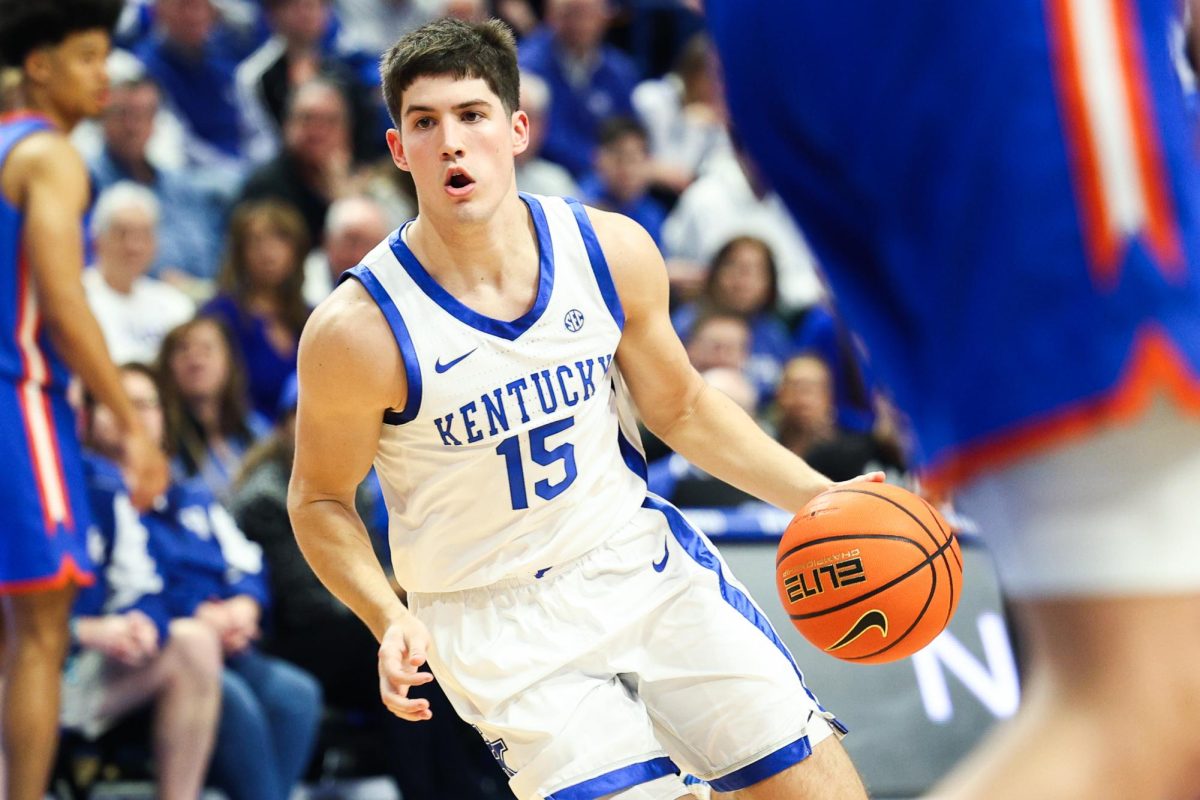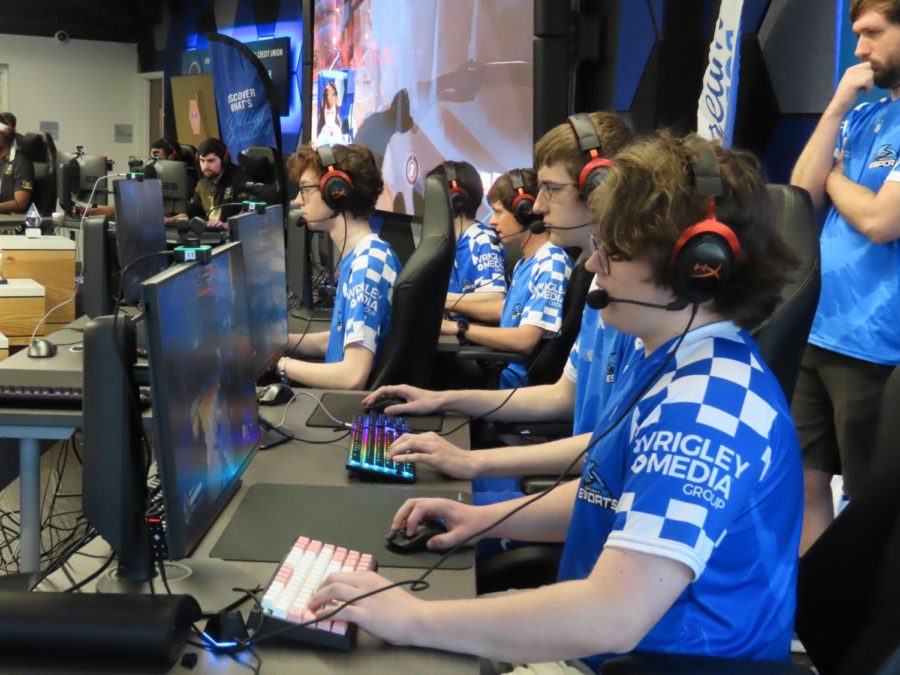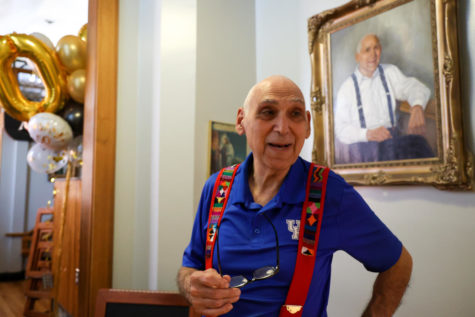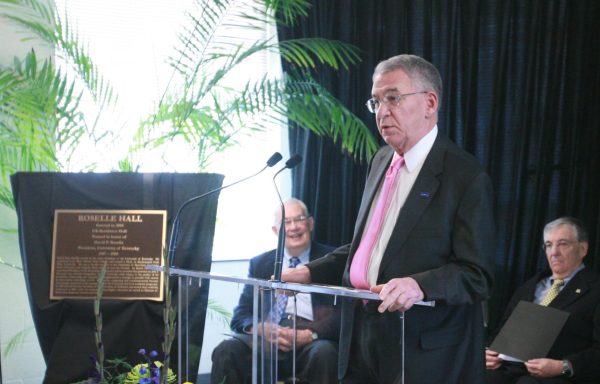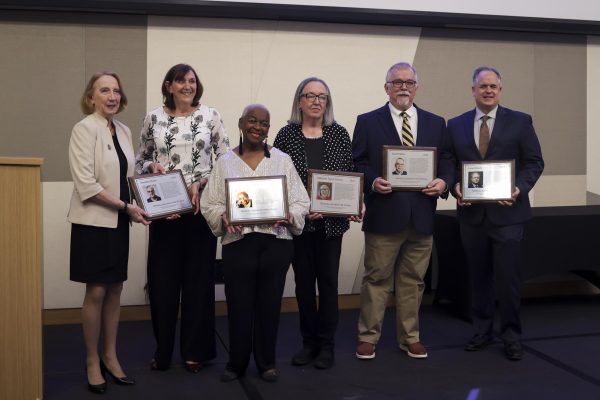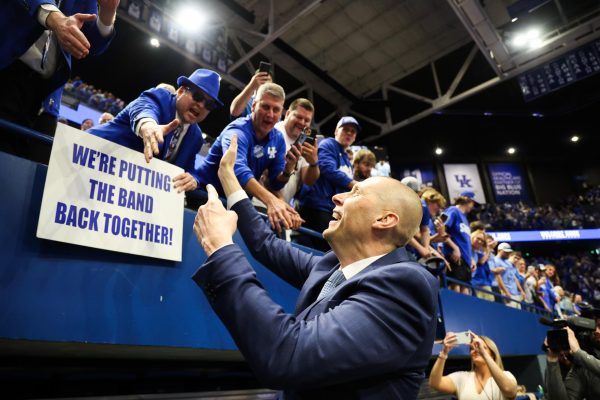Living through the nightmare
December 3, 2007
Bill Fuller stopped counting how many times he was told he would die years ago.
Sitting in his Malabu Drive apartment, Fuller lights a generic ultra-light and exhales. At 44, his skin clings closer to his skeleton, sinking into his cheeks. His thin arms and legs look like limbs that once claimed more weight. Fuller, who weighs about 180 pounds, has dropped to as little as 130 pounds since he was diagnosed with HIV in 1986, a time when the disease was a “death sentence.â€
“Just about everybody else I knew had already died,†Fuller says. “I should be dead, really, to tell you the truth. But I’m still kicking for some reason.
“That doesn’t mean that I haven’t had everything else.â€
His HIV, and the onset of AIDS since the early 1990s, have opened Fuller’s body up to a slew of illnesses.
Fuller’s parents, Sandy and John, say he has had four serious strokes since his diagnosis. After one stroke left severe muscle and nerve damage on his right side, he had to teach himself to write and walk again. He still walks with a limp.
Fuller is legally blind in his left eye after a bout with shingles a couple of years ago that also left nerve damage. Besides dealing with a loss of strength, daily aches, pains and fatigue, and nausea and diarrhea on a weekly basis, Fuller has irreversible nerve damage as a side effect of some of his medication.
For Fuller, walking feels more like stepping on broken glass. The stabbing pains also shoot through his fingertips. He takes medicine to help control the pain, but it is simply something he has to deal with, his doctors tell him.
He doesn’t go out much for fear of getting sick; even a common cold can take him months to get over. He cannot drive because he has had violent seizures caused by HIV accumulating on his brain, which also has caused dementia, affecting his memory.
But Fuller says the most significant change since he was diagnosed has been how the disease opened his eyes.
“It’s made me more aware of how judgmental people can be,†Fuller says. “Hate is a choice. Prejudice is a big choice.â€
“It’s kind of hard to put into words what that experience is unless you have HIV,†he says. “But when you’re crucified with HIV, then your eyes are real wide open, and you can’t really describe to somebody who is HIV-negative what that is.â€
Diagnosis
Up until the final seconds before Fuller found out he was HIV-positive, he never thought he was at risk. As a gay man, Fuller was well aware that HIV was only considered a gay disease when it was first diagnosed among homosexual men in Los Angeles and New York. Fuller remembers reading a newspaper article that called the disease “the gay cancer.†Before the acronym HIV was used, some doctors called it GRID — gay-related immunodeficiency.
But Fuller thought he was safe in Lexington because HIV was predominantly a problem for larger cities.
“A lot of kids don’t think that it would ever happen to them,†Fuller says. “I didn’t. Hell, when I caught HIV, it was happening at New York and Los Angeles. I didn’t think it was happening in little Bum-F—, Egypt here. And sure enough, that’s where I caught it.â€
Fuller says he doesn’t need two hands to count the number of same-sex partners he’s had. And for nearly every one, he practiced safe sex. Except for a few times. When he contracted HIV, he was out of condoms.
“I didn’t catch HIV because I was gay; I caught it because I was stupid,†Fuller says, taking a drag off his cigarette.
At 23, living and working in Lexington, Fuller was checked into a hospital after coming down with pneumonia around Thanksgiving in 1986.
The young man sat waiting in a hospital gown after doctors ran a series of tests on him. Eventually, one doctor returned to his room and told him he had tested positive for HIV, though the doctor called it GRID.
Immediately, Fuller says, hospital staff started putting large yellow and purple stickers on his door. He heard janitors outside in the hall arguing, saying they didn’t want to mop Fuller’s room because he was HIV-positive. Even in the early ‘90s, Fuller’s parents remember seeing his food left outside his door at hospitals because staff didn’t want to come into contact with him.
“It was terrible,†Fuller says. “When I was diagnosed, there wasn’t groups or any HIV functions or anything around here. Most people didn’t want to touch you, didn’t want to talk to you, didn’t want you to be in the same vicinity as they were. If you didn’t die from HIV, they would have killed you anyway.â€
At one point right after his diagnosis, Fuller walked up to a nurse to ask her a question. She ran from him, Fuller says, and wouldn’t speak to him until she was behind a shut door, talking through it like she was “afraid to breathe the same air.â€
“That’s when the nightmare began,†he says. “It’s been nothing but a nightmare ever since.â€
Youth at risk
Fuller was 23 when he contracted HIV. Young people are still at risk for the virus and have made up an increasing portion of new HIV diagnoses in recent years, says Dr. Alice Thornton, program director of the Kentucky AIDS Education Training Center.
“That’s really a change from what we’ve seen in the past,†Thornton says. “It’s a disturbing trend, and it has been happening across the country for the past two, three, maybe five years.â€
About 60 percent of the new patients who come into the Bluegrass Care Clinic at UK, which specializes in HIV/AIDS care, have been between the ages of 25 and 44, younger than previous years, she says.
The clinic, where Thornton also serves as project director, has had some patients coming in as young as 15 and 16.
More than 1 million Americans are living with HIV, according to the Centers for Disease Control and Prevention. Of those, 2,563 are Kentuckians. Lexington has the second-largest concentration of AIDS patients in the state with 382, second to Louisville’s 1,027, according to a December 2006 report from the Kentucky Department for Public Health.
Kentucky also has slightly higher rates of young people living with AIDS than the rest of the country.
Five percent of the state’s AIDS patients are between the ages 13 and 24, compared to 4 percent nationally; 74 percent of Kentucky’s AIDS population is between 25 and 44, compared to 71 percent nationally.
Dr. Kraig Humbaugh, director of epidemiology for the Kentucky Department for Public Health, says the state’s AIDS cases have declined over time, but because Kentucky doesn’t currently have a database on HIV patients, he couldn’t comment on increases in youth who have been infected.
Improved medical care is a “double-edged sword†in HIV/AIDS awareness, Humbaugh says. He fears people will grow complacent or overly optimistic and not recognize the virus as a terminal disease.
Terry Mullins feels the same way.
Mullins is the director of Moveable Feast. Every weekday, his organization delivers about 90 hot, free dinners to HIV and hospice patients who have financial problems. Lexington is the smallest city to have such a program, Mullins says.
Fuller has been a client of Moveable Feast since it started in 1998. He hasn’t had a job since the early 1990s. Most of his disability check goes to his rent and bills; after that he has about $200 for food, cigarettes and everything else for the rest of the month. The meals delivered to his door make up about 95 percent of his diet.
Mullins, who has been involved with HIV/AIDS efforts since the early 1990s, says many young people have grown up hearing about AIDS and don’t recognize it as a threat.
“They’ve lived with it all their lives,†Mullins says. “They’ve heard it, they hear about the new medications, they think people are living longer, they think of it, a lot of times, just like diabetes, that you take a pill and you go on every day. But it’s not quite like that.â€
Medicine
Major improvements in HIV treatment started in 1996 when doctors found that a three-drug “cocktail†fights the disease more effectively than one prescription, Thornton says.
Now, more people are living — and living healthier — with HIV than ever before. Medications are becoming simpler, progressing to the point where patients will only have to take one pill a day, Thornton says.
But there is still no cure. The cocktail of pills usually brings side effects such as nausea and diarrhea, she says. To be effective, HIV/AIDS medications need to be taken 98 to 100 percent on schedule, something that is difficult for many to accept or comply with, Thornton says.
And treatments can run into complications.
HIV can grow resistant to medications, and a person can be infected with a resistant strain of the virus. About 25 percent of the patients at Thornton’s clinic have resistant viruses, she says, and non-resistant viruses have a 50 percent chance of growing resistant once a patient starts medication.
“Even though, yes, we have helped patients stay healthy and they could accomplish their goals, life would be much sweeter without HIV,†Thornton says.
“It may not seem like a big problem, but it is for folks who live with this day in and day out.â€
More than 13 orange prescription bottles filled with pills sit on Fuller’s bedside table.
The meds are the worst part of life with HIV/AIDS, Fuller says.
“God, I take so much damn medicine,†he says. “I take so many pills, I’m a legal junkie.â€
On the good days, Fuller takes about 24 pills from 13 different medications. On the bad days, he takes more. Most new patients have to take far fewer pills, Thornton says.
Growing bonsai trees is Fuller’s self-therapy — a hobby to pass the time and fill his days. He has 11 growing in his small apartment on shelves near the windows, and he takes care of some for friends.
Besides the pills and his trees, coffee and cigarettes keep Fuller going. Doctors and his parents have tried to get him to stop smoking, but he can’t.
“I have to smoke because I’m so freaking nervous all the time,†he says. “Cigarettes seem to help a little,†but it’s probably because he’s addicted, he says, giving a raspy, staccato laugh, revealing a silver tongue piercing.
Fuller is quick to joke about his condition. When asked if there was anything he missed from his life before HIV, he mentions dancing — the stroke that gave him a limp keeps him from that — followed by the loss of his butt.
The weight he’s lost has taken away what was “a pretty nice figure,†he says, looking over his glasses.
But some things he doesn’t joke about.
“I really don’t miss much of anything anymore other than trying to be normal, like normal people,†he says after drumming his fingers on his upper lip, thinking of the past. “But I’m not normal.â€
Stigma
In the world of the late 1980s, Fuller was even less normal. The stigma that comes with HIV was too much for some, Fuller says. Some patients killed themselves. Fuller tried — twice.
He turns his wrists over and points to three sets of scars. The first try, which left thin, defined slits across both wrists, was for attention, he says. The second attempt, now a thick mark of scar tissue running down his left forearm, was for death.
After he was diagnosed, his friends started dropping him out of their lives, he says. Slowly, people stopped wanting to see him and stopped inviting him out and to parties. Later, he learned, someone had started a rumor that he lied about his HIV for attention.
A few years after his diagnosis, Fuller went to confession at a Catholic church in Lexington. He says he told the priest everything, that he was gay and that he was HIV-positive. When he went up for communion, he was refused and told that he should find another church.
Rejected by his friends, the church and much of society because of his disease, Fuller didn’t see a point to living with HIV any longer. One night a few years after his diagnosis, he decided to try to kill himself for the second time. In his downtown apartment, he got drunk and took sleeping pills before dragging a razor blade down his left forearm. Fuller doesn’t remember who found him or who called the ambulance, but he ended up in the hospital that night.
He was transferred to Eastern State Hospital, a mental institution, because of his suicide attempt, and he started thinking about living.
He stopped doing drugs, started concentrating on taking his medication and — with the exception of smoking — started taking care of himself. And to the surprise of many, himself included, he kept living.
“When I was first diagnosed in ‘86, everybody else was dying,†he says. “And I expected to die because I was told I was gonna die and that was that. Three months turned into six months, and six months turned into a year, and a year turned into three and so on and so on and so on, and finally they just got tired of telling me when I was gonna die.â€
Fuller kept surviving, and acceptance began to replace fear of his eventual death.
“I used to be so afraid of death,†he says more than 20 years after his diagnosis. “But I’m not afraid anymore. It’s just a part of life. Everybody’s going to die. Everybody. It’s just a matter of how and when.â€
Sandy Fuller is a mother who knows her son’s funeral arrangements: Fuller wants to be cremated and has made an urn out of a gourd from a friend’s farm.
After years of watching out for her son and organizing his medications after Fuller couldn’t keep track, she worries who will take care of him if something happens to her or her husband. She tries not to think about his death.
“It’s not something I sit around and think about all the time … I try not to think of that, it’s —†She pauses. John Fuller sits next to her, rubbing her hand. “It’s sad,†she says.
“When Bill goes, part of me goes.â€
But for Fuller, having experienced the emotional pain of rejection and the physical pain of the disease, death will be more of a release, he says. He’s past the point of wanting to speed up the process. Every day he wakes up is a blessing, Fuller says, but when his time comes, he’ll be ready.
“I would be freaked out at first, I’m sure, just like anybody else. But then after you sit there and think about it, think about not being in pain anymore, not having to take pills, not seeing doctors, not going to hospitals, not having tubes stick up in you, stuff like that, it’s not that big of a deal,†he says, with distant sirens wailing outside his window. “It’s not that big of a deal.â€
Living and accepting
A knock sounds at Fuller’s apartment door. It’s Mullins, delivering his meal from Moveable Feast the night before Thanksgiving. It’s close to the anniversary of Fuller’s diagnosis, and also an anniversary for Mullins, who lost a close friend because of AIDS around this time in the early ‘90s. They speak briefly, exchanging pleasantries, then Fuller says goodbye and goes back into his apartment, where he spends most his time alone.
Fuller’s weakened immune system and nerve damage keep him from going out much, or spending much time with his nieces and nephews. Loneliness is a silent symptom of HIV/AIDS.
“I’m lonely, just like everybody else,†he says. “Just about all HIV-positive people suffer loneliness more than anything.â€
“They either have come out and told people that they’re HIV-positive and are dealing with rejection, or they haven’t told anybody and are dealing with their own rejection,†he says. “It goes both ways.â€
The last work Fuller did in public was with AIDS Volunteers of Lexington, touring the state as a speaker. He visited churches, schools and universities, as well as doctors and nurses a couple times a month, educating them on how everyone is at risk for HIV, how to protect themselves and what it’s like to be a patient. Sandy Fuller joined him for the last year.
“I think it was very valuable,†Fuller says of his volunteering. “Extremely valuable for people who were learning about HIV and extremely valuable for people in the audience who had HIV, who saw a person who was not afraid to say, ‘Hey, look at me. This happened to me, it can happen to you.’ â€
Fuller says the first time he spoke was “not pretty.†It was at Morehead State University, and he was the only HIV-positive person on a panel.
During a question-and-answer session, one man in the audience stood up and asked Fuller if he had asked God for forgiveness.
It sparked a commotion, but Fuller said he wanted to answer the question.
“Yeah,†he replied. “I’ve asked God for forgiveness, but have you asked God for understanding?â€
Sandy Fuller wrestled with keeping her son’s disease a secret from outsiders, afraid of what would happen to her family, in the first year after his diagnosis. But these trips into Eastern and Central Kentucky brought her closer to her son, she says.
“He was such a positive role model for these kids. He had been there, he was in the middle of it, he could tell them what they were doing,†she says. “He was great.â€
After three or four years, Fuller got sick and stopped speaking publicly. It was very taxing on him, Sandy Fuller says. He wasn’t eating or resting like he should, and visiting schools exposed him to many germs.
On some level Fuller wishes he could still speak publicly, but he says if he did, it would most likely kill him. He’s put in his time as a “soldier†and a “casualty of this war.†But the dialogue that he worked for has to continue, he says, until there is a cure. Or until more people listen.
“I’ll tell you what,†Fuller says. “When I do croak, they will say, ‘Well, he did everything he could to try to stop this from happening to other people.’ It’s just if they will listen.
“And so many people will not listen.â€








































